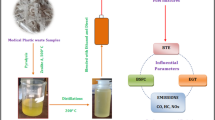Abstract
Disposal of hazardous waste engine oil (WEO) has become the forefront of climate change. Hence, the potential conversion of WEO is essential and also recycled through different pyrolysis techniques for better assessment. In this work, diesel-like fuel extracted from electrical pyrolysis and microwave pyrolysis was used as an alternative fuel for the CI engine. The pyrolysis oil generated by both pyrolysis processes was found to be reliable. Nevertheless, the physicochemical characteristics of both pyrolysis oil deviated from each other. The performance, combustion and emission characteristics of different pyrolysis fuel have been investigated to identify the suitable alternative fuel for CI engine. The performance characteristics at rated load revealed that the brake thermal efficiency of electrical pyrolysis oil (EPO) and microwave pyrolysis oil (MPO) was 26% and 25%, respectively, which was 0.8% and 1.5% lower than diesel due to its higher viscosity. Emission characteristic shows that unburnt hydrocarbon emission of EPO and MPO was higher than diesel by 7% and 15%, respectively. Similarly, the filter smoke number was 3% and 10% higher than diesel. NO emission of EPO and MPO was lower than diesel by 27% and 13%, respectively. Also, exergy analysis represents MPO has higher potential when compared to EPO due to higher exergy efficiency.

















Similar content being viewed by others
Abbreviations
- AC:
-
Activated carbon
- ASTM:
-
American Society for Testing and Materials
- BTE:
-
Brake thermal efficiency/%
- BMEP:
-
Brake mean effective pressure/bar
- BSEC:
-
Brake specific energy consumption/MJ kWh−1
- CA:
-
Crank angle/degree
- CI:
-
Compression ignition
- CO:
-
Carbon monoxide/vol%
- CO2 :
-
Carbon dioxide/vol%
- DI:
-
Direct injection
- EPO:
-
Electrical pyrolysis oil
- FEO:
-
Fresh engine oil
- FSN:
-
Filter smoke number
- GC–MS:
-
Gas chromatography and mass spectrometry
- HRR:
-
Heat release rate/J deg−1 CA−1
- MAP:
-
Microwave-assisted pyrolysis
- MPO:
-
Microwave pyrolysis oil
- NCG:
-
Non-condensable gases
- NO:
-
Nitric oxide/ppm
- NOx :
-
Oxides of nitrogen/ppm
- PAHs:
-
Polycyclic aromatic hydrocarbons
- ppm:
-
Parts per million
- PO:
-
Pyrolysis oil
- UBHC:
-
Unburnt hydrocarbon/ppm
- WEO:
-
Waste engine oil
References
Cormier SA, Lomnicki S, Backes W, Dellinger B. Origin and health impacts of emissions of toxic by-products and fine particles from combustion and thermal treatment of hazardous wastes and materials. Environ Health Perspect. 2006;114:810–7.
Lam SS, Chase HA. A review on waste to energy processes using microwave pyrolysis. Energies. 2012;5:4209–32.
Santhoshkumar A, Anand R. Microwave-assisted fast pyrolysis of hazardous waste engine oil into green fuels. In: Kalam A (ed) Advances in eco-fuels for a sustainable environment. 2019, pp 119–55.
Lam SS, Russell AD, Chase HA. Pyrolysis using microwave heating: a sustainable process for recycling used car engine oil. Ind Eng Chem Res. 2010;49:10845–51.
Gómez-Rico MF, Martín-Gullón I, Fullana A, Conesa JA, Font R. Pyrolysis and combustion kinetics and emissions of waste lube oils. J Anal Appl Pyrolysis. 2003;68–69:527–46.
Lalvani JIJR, Parthasarathy M, Dhinesh B, Annamalai K. Pooled effect of injection pressure and turbulence inducer piston on performance, combustion, and emission characteristics of a DI diesel engine powered with biodiesel blend. Ecotoxicol Environ Saf. 2016;134:336–43.
Thiyagarajan S, Sonthalia A, Edwin Geo V, Prakash T, Karthickeyan V, Ashok B, et al. Effect of manifold injection of methanol/n-pentanol in safflower biodiesel fuelled CI engine. Fuel. 2020;261:116378.
Mohan D, Pittman CU, Steele PH. Pyrolysis of wood/biomass for bio-oil: a critical review. Energy Fuels. 2006;20:848–89.
Lam SS, Russell AD, Chase HA. Microwave pyrolysis, a novel process for recycling waste automotive engine oil. Energy. 2010;35:2985–91. https://doi.org/10.1016/j.energy.2010.03.033.
Sharma BK, Moser BR, Vermillion KE, Doll KM, Rajagopalan N. Production, characterization and fuel properties of alternative diesel fuel from pyrolysis of waste plastic grocery bags. Fuel Process Technol. 2014;122:79–90. https://doi.org/10.1016/j.fuproc.2014.01.019.
Huang YF, Te Chiueh P, Lo SL. A review on microwave pyrolysis of lignocellulosic biomass. Sustain Environ Res. 2016;26:103–9.
Wang XH, Chen HP, Ding XJ, Yang HP, Zhang SH, Shen YQ. Properties of gas and char from microwave pyrolysis of pine sawdust. BioResources. 2009;4:946–59.
Onay O, Kockar OM. Slow, fast and flash pyrolysis of rapeseed. Renew Energy. 2003;28:2417–33.
Tripathi AK, Ojha DK, Vinu R. Selective production of valuable hydrocarbons from waste motorbike engine oils via catalytic fast pyrolysis using zeolites. J Anal Appl Pyrolysis. 2015;114:281–92.
Liu WJ, Tian K, Jiang H, Zhang XS, Ding HS, Yu HQ. Selectively improving the bio-oil quality by catalytic fast pyrolysis of heavy-metal-polluted biomass: take copper (Cu) as an example. Environ Sci Technol. 2012;46:7849–56.
Lam SS, Liew RK, Cheng CK, Chase HA. Catalytic microwave pyrolysis of waste engine oil using metallic pyrolysis char. Appl Catal B Environ. 2015;176–177:601–17. https://doi.org/10.1016/j.apcatb.2015.04.014.
Domínguez A, Menéndez JA, Inguanzo M, Bernad PL, Pis JJ. Gas chromatographic-mass spectrometric study of the oil fractions produced by microwave-assisted pyrolysis of different sewage sludges. J Chromatogr A. 2003;1012:193–206.
Yin C. Microwave-assisted pyrolysis of biomass for liquid biofuels production. Bioresour Technol. 2012;120:273–84.
Hussain Z, Khan KM, Hussain K. Microwave-metal interaction pyrolysis of polystyrene. J Anal Appl Pyrolysis. 2010;89:39–43.
Zhang Y, Chen P, Liu S, Peng P, Min M, Cheng Y, et al. Effects of feedstock characteristics on microwave-assisted pyrolysis—a review. Bioresour Technol. 2017;230:143–51.
Lam SS, Wan Mahari WA, Jusoh A, Chong CT, Lee CL, Chase HA. Pyrolysis using microwave absorbents as reaction bed: an improved approach to transform used frying oil into biofuel product with desirable properties. J Clean Prod. 2017;147:263–72.
Suriapparao DV, Vinu R. Resource recovery from synthetic polymers via microwave pyrolysis using different susceptors. J Anal Appl Pyrolysis. 2015;113:701–12. https://doi.org/10.1016/j.jaap.2015.04.021.
Salema AA, Ani FN. Microwave-assisted pyrolysis of oil palm shell biomass using an overhead stirrer. J Anal Appl Pyrolysis. 2012;96:162–72. https://doi.org/10.1016/j.jaap.2012.03.018.
Ramanathan A, Santhoshkumar A. Feasibility analysis of pyrolysis waste engine oil in CRDI diesel engine. Energy Procedia. 2019;158:755–60.
Thiyagarajan S, Sonthalia A, Edwin Geo V, Ashok B, Nanthagopal K, Karthickeyan V, et al. Effect of electromagnet-based fuel-reforming system on high-viscous and low-viscous biofuel fueled in heavy-duty CI engine. J Therm Anal Calorim. 2019;138:633–44.
Elumalai PV, Annamalai K, Dhinesh B. Effects of thermal barrier coating on the performance, combustion and emission of DI diesel engine powered by biofuel oil–water emulsion. J Therm Anal Calorim. 2019;137:593–605.
Kalargaris I, Tian G, Gu S. Combustion, performance and emission analysis of a DI diesel engine using plastic pyrolysis oil. Fuel Process Technol. 2017;157:108–15. https://doi.org/10.1016/j.fuproc.2016.11.016.
Vigneswaran R, Annamalai K, Dhinesh B, Krishnamoorthy R. Experimental investigation of unmodified diesel engine performance, combustion and emission with multipurpose additive along with water-in-diesel emulsion fuel. Energy Convers Manag. 2018;172:370–80.
Vedharaj S, Vallinayagam R, Yang WM, Chou SK, Lee PS. Effect of adding 1,4-Dioxane with kapok biodiesel on the characteristics of a diesel engine. Appl Energy. 2014;136:1166–73.
Nanthagopal K, Ashok B, Garnepudi RS, Tarun KR, Dhinesh B. Investigation on diethyl ether as an additive with calophyllum inophyllum biodiesel for CI engine application. Energy Convers Manag. 2019;179:104–13.
Arpa O, Yumrutas R, Demirbas A. Production of diesel-like fuel from waste engine oil by pyrolitic distillation. Appl Energy. 2010;87:122–7. https://doi.org/10.1016/j.apenergy.2009.05.042.
Beg RA, Sarker MRI, Pervez MR. Production of diesel fuel from used engine oil. Int J Mech Mech Eng. 2010;10:1–6.
Arpa O, Yumrutaş R, Argunhan Z. Experimental investigation of the effects of diesel-like fuel obtained from waste lubrication oil on engine performance and exhaust emission. Fuel Process Technol. 2010;91:1241–9.
Arpa O, Yumrutas R, Alma MH. Effects of turpentine and gasoline-like fuel obtained from waste lubrication oil on engine performance and exhaust emission. Energy. 2010;35:3603–13. https://doi.org/10.1016/j.energy.2010.04.050.
Murugan S, Ramaswamy MC, Nagarajan G. A comparative study on the performance, emission and combustion studies of a DI diesel engine using distilled tyre pyrolysis oil-diesel blends. Fuel. 2008;87:2111–21.
Hossain AK, Davies PA. Pyrolysis liquids and gases as alternative fuels in internal combustion engines—a review. Renew Sustain Energy Rev. 2013;21:165–89. https://doi.org/10.1016/j.rser.2012.12.031.
Sathiyamoorthi R, Sankaranarayanan G. Effect of antioxidant additives on the performance and emission characteristics of a DICI engine using neat lemongrass oil-diesel blend. Fuel. 2016;174:89–96.
Yang Y, Brammer JG, Ouadi M, Samanya J, Hornung A, Xu HM, et al. Characterisation of waste derived intermediate pyrolysis oils for use as diesel engine fuels. Fuel. 2013;103:247–57.
Murugan S, Ramaswamy MC, Nagarajan G. Assessment of pyrolysis oil as an energy source for diesel engines. Fuel Process Technol. 2009;90:67–74. https://doi.org/10.1016/j.fuproc.2008.07.017.
Hürdoğan E, Ozalp C, Kara O, Ozcanli M. Experimental investigation on performance and emission characteristics of waste tire pyrolysis oil–diesel blends in a diesel engine. Int J Hydrogen Energy. 2017;42:23373–8.
Shihadeh A, Hochgreb S. Diesel engine combustion of biomass pyrolysis oils. Energy Fuels. 2000;14:260–74. https://doi.org/10.1021/ef990044x.
Hossain AK, Ouadi M, Siddiqui SU, Yang Y, Brammer J, Hornung A, et al. Experimental investigation of performance, emission and combustion characteristics of an indirect injection multi-cylinder CI engine fuelled by blends of de-inking sludge pyrolysis oil with biodiesel. Fuel. 2013;105:135–42. https://doi.org/10.1016/j.fuel.2012.05.007.
Tamilvanan A, Balamurugan K, Vijayakumar M. Effects of nano-copper additive on performance, combustion and emission characteristics of calophyllum inophyllum biodiesel in CI engine. J Therm Anal Calorim. 2019;136:317–30.
Acknowledgements
The authors would like to acknowledge the Department of science and technology—Science and Engineering Research Board (DST-SERB) for providing funding to carry out the research project (Project No. DST/SB/EMEQ-251). Also, the authors acknowledge the Director, National Institute of Technology, Tiruchirappalli, Tamil Nadu, India, for supporting and extending the facility to the successful completion of this research work.
Author information
Authors and Affiliations
Corresponding author
Additional information
Publisher's Note
Springer Nature remains neutral with regard to jurisdictional claims in published maps and institutional affiliations.
Rights and permissions
About this article
Cite this article
Zahir Hussain, A., Santhoshkumar, A. & Ramanathan, A. Assessment of pyrolysis waste engine oil as an alternative fuel source for diesel engine. J Therm Anal Calorim 141, 2277–2293 (2020). https://doi.org/10.1007/s10973-020-09516-y
Received:
Accepted:
Published:
Issue Date:
DOI: https://doi.org/10.1007/s10973-020-09516-y




